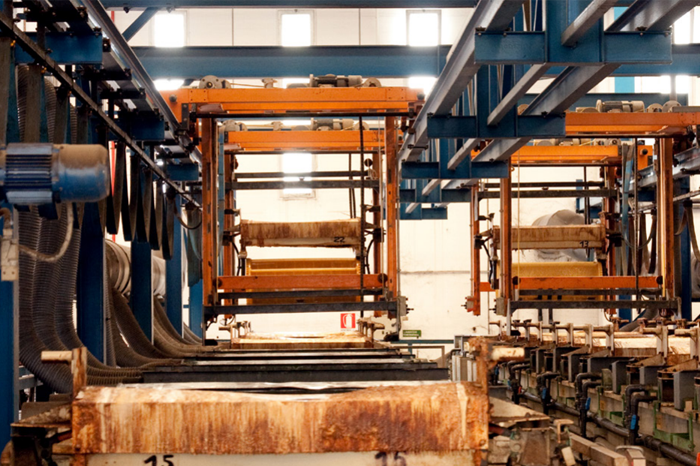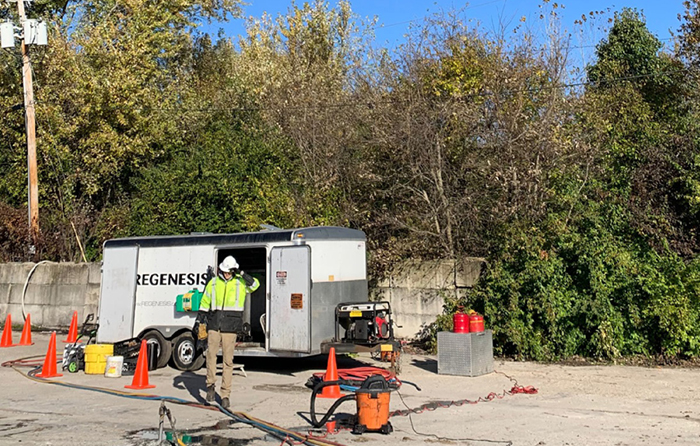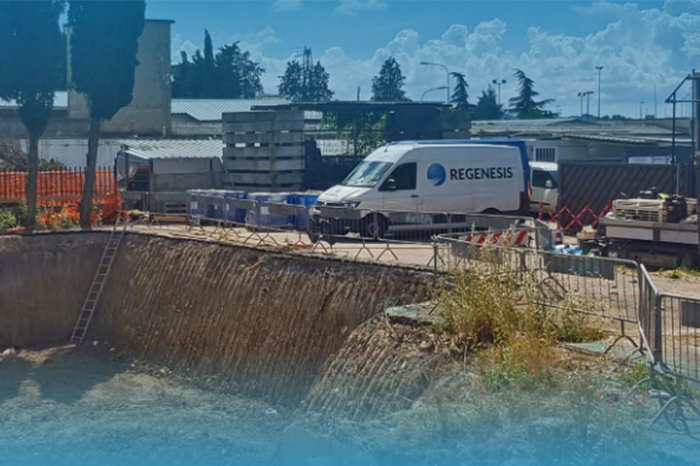Effective In-Situ Treatment of a 3,280 Ft. PCE Plume in Finland
Case study highlights:
- PCE concentrations were reduced to below the drinking water limit at the water supply well
- Results indicate that the ERD and PlumeStop approach can be successfully applied in cold groundwater aquifers with low organic carbon content
- Integrated source area/PlumeStop-ERD barrier treatment is an effective strategy for treating elongated chlorinated solvent plumes
In Eastern Finland, a fast-moving PCE (perchloroethene) plume beneath a metal-processing facility was remediated to reduce impacts on a municipal drinking water source. The demonstration project achieved PCE concentration reductions of approximately 80% in the plume within months and 90 to 95% by 18 months, ultimately reducing PCE to below the drinking water limit at the municipal water supply well. The in situ remedy applied enhanced reductive dechlorination (ERD) beneath the source area at the industrial building, combined with downgradient plume area treatment comprising ERD plus adsorption, facilitated by PlumeStop, to form an injectable permeable reactive barrier. The progressive approach uses relatively few injection points to reduce the contaminant flux into the plume and to impede contaminant migration downgradient, resulting in the effective and economical treatment of a 3,280-ft.-long chlorinated solvent plume to mitigate the potential exposure risk.
Full Life Cycle Analysis Conducted by Ramboll Finds PlumeStop Has 98% Lower Carbon Footprint than Pump & Treat for PFAS Remediation
Case study highlights:
- Study concludes that PlumeStop results in a 98% lower total carbon footprint than pump & treat
- Immobilization with PlumeStop offers >64% lower costs compared to ex situ treatment approaches
- Colloidal activated carbon (CAC) requires no operational energy, maintenance, or PFAS-saturated waste products
A recent independent sustainability study (full Life Cycle Analysis) conducted by Ramboll, a global environmental consulting and engineering firm, evaluated the use of PlumeStop vs. conventional pump and treat technology to eliminate PFAS. The findings revealed the use of PlumeStop technology would reduce GHG emissions by 98% and would reduce the cost by >64%. This study included a Life Cycle Cost Analysis (LCCA) and a Tier 2 sustainability assessment using Ramboll’s SURE model. The overall Sustainability Assessment Score for PlumeStop was 100% higher than the ex situ, pump & treat alternatives. PlumeStop also exceeded pump & treat in each of the sustainability categories, ‘Environment’, ‘Society’ and ‘Economy’.
In Situ Treatment of Hexavalent Chromium Results in Site Closure
Case study highlights:
- Commodity ZVI and 3-D Microemulsion/CRS rapidly reduced Cr(VI) concentrations, achieving remarkable reductions within months.
- S-MicroZVI® and 3-D Microemulsion offered improved distribution and reactivity, addressing previous limitations in the remediation process.
- The use of S-MicroZVI® and 3-D Microemulsion led to a rapid 99% reduction in Cr(VI) concentrations, securing regulatory closure for a long-standing contamination case.
This case study focuses on the successful remediation of hexavalent chromium (Cr(VI)) contamination at a chrome plating facility in the Midwest. Decades of ineffective pump & treat (P&T) operations led to the need for a cost-effective and rapid solution to achieve regulatory closure. Enviroforensics, an environmental engineering and remediation firm, directed the pilot test efforts, which aimed to determine the optimal remedial approach for Cr(VI) treatment. The study found that in situ chemical reduction combined with in situ bioremediation (ISCR-BR) effectively reduced Cr(VI) concentrations, with promising results from two different remediation amendments: a viscous zero-valent iron (ZVI)/organic mixture and a 3-D Microemulsion/Chemical Reducing Solution® (CRS) mixture. Demonstrating that the combination of S-MicroZVI® and 3-D Microemulsion for ISCR-BR is a highly effective and efficient solution for remediating Cr(VI) contamination, particularly in situations where minimal disruption is crucial. These colloidal amendments offer superior distribution capabilities, making them ideal for treating a wide range of contaminants in various subsurface environments.
PlumeStop Cost-Efficiently Eliminates PFAS Long-Term
Case study highlights:
- PFAS concentrations reduced to non-detect within 3 months post-application, results maintained more than 8 years later
- In situ treatment reduces lifecycle remediation costs vs. pump & treat
- Low Injection Pressures less than 25 PSI maintained throughout PlumeStop direct push application
- Sampling confirms PlumeStop fully distributed through the treatment zone
- Modeling indicates that PlumeStop will halt PFAS migration out of the treatment zone for more than 60 years
This case study reviews the first known full-scale in situ PFAS treatment worldwide completed in 2016 at a manufacturing and former firefighting training site in Ontario, Canada, where aqueous film-forming foams (AFFF) were used. A single application of PlumeStop resulted in a significant reduction of contaminant concentrations, achieving non-detect levels within three months post-application and maintaining these reductions for over eight years. An independent fate and transport modeling expert predicts that PlumeStop will halt PFAS migration out of the treatment zone for more than 60 years, preventing exposure risk and reducing liabilities for the site owner.
Cost-effective In Situ Remediation of Chlorinated Solvents in Svenljunga, Sweden
Case study highlights:
- In situ remediation of groundwater contaminated with Trichloroethylene (TCE) was chosen for a former fur factory in Svenljunga, Sweden, as excavation or thermal treatment was deemed too expensive.
- A targeted application of 3-D Microemulsion® using direct push technology (DPT) successfully reduced groundwater and soil concentrations of TCE, DCE, and VC by approximately 95%, well below remedial targets.
- The chosen remediation method, 3-D Microemulsion injection, was not only effective in achieving significant contaminant reduction but also cost-effective, with a cost of €21/tonne compared to the more expensive alternatives of excavation and thermal remediation.
In situ remediation of groundwater impacted with Trichloroethylene (TCE) was completed at a former fur factory in Svenljunga, Sweden, as it had been determined that excavation or thermal treatment would have been too expensive. A targeted application of 3-D Microemulsion® was performed using direct push technology (DPT) to complete the injections. Validation sampling showed that the concentrations in the groundwater and soils had been reduced by approx. 95%, to well below the remedial targets. 3-D Microemulsion (3DME) is an engineered electron-donor emulsion that offers a steady and long-term source of staged-release hydrogen (in the order of 4 to 5 years from a single application) to enhance the reductive dechlorination (ERD) of chlorinated compounds. It has been optimized to distribute widely upon injection, allowing for high volume applications, reducing the number of injection points and events required onsite. Click the logo to learn more about how 3DME works.
Reductive Dechlorination Approach Treats Large Chlorinated Solvent Plume
Case study highlights:
- Innovative combined remedy on active site effectively eliminates risk to adjacent property
- Remedy from REGENESIS chosen based on proven effectiveness in treating similar large CVOC plumes
- Design Verification Testing and placement validation guide a successful remedial application
This case study reviews the successful in-situ treatment of chlorinated solvents at a former food processing plant located in a suburb south of Indianapolis. PlumeStop, S-MicroZVI, 3DME and BDI Plus were used in combination to strongly inhibit CVOC plume migration near the site property boundary while enhancing abiotic and biotic degradation of CVOCs at this location and in the upgradient plume area. Patriot Engineering and Environmental, Inc. (Patriot), a leading consulting firm based in Indianapolis, investigated the site, discovering contaminants had migrated from an unidentified source and formed a large plume. In addition, it was found that the plume was being pulled toward a former (now inactive) public water supply well. The primary chlorinated volatile organic compounds (CVOCs) detected in the plume were tetrachloroethene (PCE), trichloroethene (TCE), and cis-1,2-dichloroethene (cis-DCE).
Injectable PRB Provides Rapid Remediation of Chlorinated Plume Allowing Redevelopment within Months
Case study highlights:
- An in situ permeable reactive barrier (iPRB) was installed combining PlumeStop, S-MicroZVI and BDI Plus reagents
- Additional Design Verification Testing (DVT) was completed by REGENESIS prior to full-scale works
- Remediation targets and the client’s economic requirements were achieved on time and within budget, under a guaranteed contract
Stringent regulatory targets achieved in short timescale, despite challenging site conditions. Historical industrial activities at a former silver frames manufacturing facility in Central Italy had caused chlorinated solvent contamination in the subsurface, which was extending beyond the site boundary. As the site was undergoing redevelopment into residential buildings, the construction company had a strict deadline for remediation to be completed and so a strategy was needed to avoid the long-term installation of active pumping equipment onsite.
Combined ISCR and ERD Remedial Approach Knocks Down PCE Concentrations in Poland
Case study highlights:
- Safe and easy co-injection of PlumeStop and S-MicroZVI
- A grid of 30 injection wells was used, with a 4m spacing between wells
- A rapid, significant drop in PCE concentrations was achieved in the entire treatment area, with no daughter products observed
- Monitoring is ongoing
Rapid groundwater treatment achieved at manufacturing plant, without daughter product build-up. At an active manufacturing plant in the region of Greater Poland, in the West of the country, historical perchloroethylene (PCE) contamination was found to be impacting both soil and groundwater. Environmental company PROTE determined that contamination originated from a number of spills and leakages that occurred over the >20 years of manufacturing on the site.The canal adjacent to the site was identified as a potential downgradient receptor vulnerable to impact from offsite advection of the contamination. Therefore, remediation was driven by a requirement to remove the site owner’s potential liability, whilst being completed within strict budgetary restrictions.
225m Permeable Reactive Barrier Treats TCE and Chromium (VI)
Case study highlights:
- A large-scale remediation project with challenging conditions: geology, underground services, ongoing site use and multiple stakeholders
- Treatment of a co-mingled chromium (VI) and TCE plume via enhanced biological dechlorination and chemical reduction, using: S-MicroZVI,
3-D Microemulsion and BDI Plus - Pilot study proves appropriateness of the proposed in situ remedial solution, allowing regulatory sign off for the full scale works.
- Post remediation monitoring results to date show significant chromium reduction and TCE below detection limits
Sustainable and cost-effective remediation of a co-mingled plume in a sensitive chalk aquifer. A 48 hectare site in the UK was to be redeveloped for mixed commercial and residential use. The existing site included a mix of historic and existing industrial land use, including a metal plating works, surrounded by agricultural land and residential housing. The Mott MacDonald engaged early with REGENESIS regarding potential options for remediation.
New York Brownfield Site Treated for PFAS Achieves Closure
Case study highlights:
- NYSDEC certifies cleanup requirements achieved, making the site eligible for redevelopment
- Brownfield cleanup program’s green remediation policy leads to PlumeStop for PFAS treatment
- PlumeStop barrier for PFAS treatment is a key component in pursuit of site closure
- Skillfully managed PlumeStop application achieves GSR and cost reduction objectives
This case study reviews a 25-acre former refinery located in a mixed-use industrial/commercial area that was contaminated with PFAS. Benchmark Environmental Engineering & Science, PLLC & TurnKey Environmental Restoration, LLC (Benchmark & TurnKey), a leading engineering and redevelopment consulting company headquartered in Buffalo, New York, engaged REGENESIS for an in situ remedy that would effectively and economically cut off the plume and prevent migration of PFAS offsite. The site was entered into the New York State Department of Environmental Conservation’s (NYSDEC’s) Brownfield Cleanup Program (BCP) to facilitate its commercial redevelopment. Remedial alternatives were evaluated for a comprehensive site closure strategy, and approaches were scored based on NYSDEC’s Green Remediation Policy Document DER-31, which considers the “environmental impacts of treatment technologies and remedy stewardship over the long term.”

 Americas
Americas Europe
Europe Français
Français Deutsch
Deutsch Italiano
Italiano Español
Español













